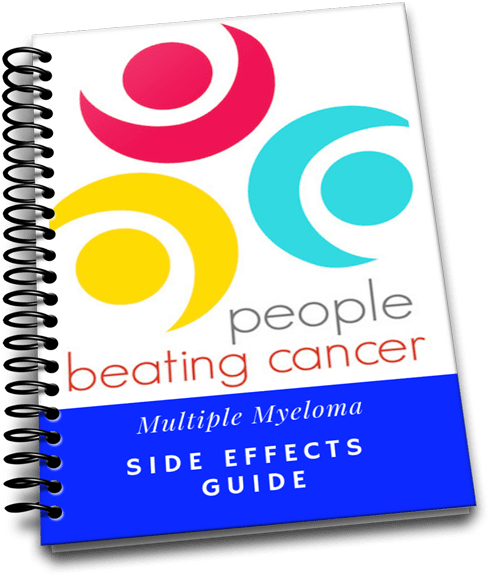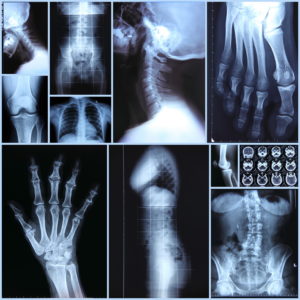
Diagnosed with Cancer? Your two greatest challenges are understanding cancer and understanding possible side effects from chemo and radiation. Knowledge is Power!
Learn about conventional, complementary, and integrative therapies.
Dealing with treatment side effects? Learn about evidence-based therapies to alleviate your symptoms.
Click the orange button to the right to learn more.
- You are here:
- Home »
- Blog »
- Multiple Myeloma »
- Myeloma Imaging- “MRI With Contrast” Gadolinium?
Myeloma Imaging- “MRI With Contrast” Gadolinium?

“Gadolinium (Gd)-based contrast agents are frequently used to enhance MRI resolution. We evaluated effect of the most common Gd-containing agent, Omniscan, on myeloma cells.”
Multiple myeloma imaging, that is to say using imaging studies such as MRI to identify MM activity, is central to managing our MM. Gadolinioum (Gd), according to the study linked below, encourages the growth of multiple myeloma.
Gd is the agent that enhances the contrast of the many MRI scans you will have during your life as a MM survivor. Or Gd is the contrast agent that you’ve been having before the many MRI scans that you have already have had if you are a long-term MM survivor.
To make matters worse, the second link below is an excerpt from a blog post written by Richard Semelka MD. The link is to Dr. Semelka’s website that focuses on Gadolinium toxicity.
In all fairness, if a healthy person with normal kidney function has an MRI with contrast (Gd) once or twice during his/her life then Gd may be worth the risks. However, if a newly diagnosed MMer with impaired kidney function is told to have an MRI, he/she may not want to risk the contrast agent aka Gd.
Unlike most of my blog posts, the solution to Gadolinium toxicity and its associatiation with MM is straightforward. You can refuse this agent before you undergo an MRI. Yes, your MRI will not offer as much contrast but I think your radiologist will be able to treat you just the same. Or to put it another way, the benefits of Gd for your MRI don’t appear to outweigh its risks.
- To learn more about managing your bone health, click now
- To Learn More About Kidney Failure in Multiple Myeloma click now
Have you been diagnosed with MM? To learn more about the pros and cons of MM blood, urine and imaging studies, scroll down the page, post a question or comment and I will reply to you ASAP.
Thank you,
David Emerson
- MM Survivor
- MM Cancer Coach
- Director Galen Foundation
Recommended Reading:
- Vitamin K2 Pro Bone, Anti-Myeloma twofer
- Bone Imaging Can Make or Break Multiple Myeloma
- Is Upfront Radiation Therapy a Negative for Myeloma Patients?
- Multiple Myeloma Symptom, Side Effect, Cause of Death
Gadolinium
“The kinds of gadolinium(III) ions occurring in water-soluble salts are toxic to mammals. However, chelated gadolinium(III) compounds are far less toxic because they carry gadolinium(III) through the kidneys and out of the body before the free ion can be released into the tissues. Because of its paramagnetic properties, solutions of chelated organic gadolinium complexes are used as intravenously administered gadolinium-based MRI contrast agents in medical magnetic resonance imaging…”
Gadolinium Containing Contrast Agent Promotes Multiple Myeloma Cell Growth: Implication for Clinical Use of MRI in Myeloma.
“Bone marrow infiltration by myeloma cells and osteolytic bone lesions are the major features of Multiple Myeloma. Magnetic Resonance Imaging (MRI) has been used in MM not only to image bone marrow (BM) and to identify lytic bone disease but to also evaluate therapeutic response and prognosis.
Gadolinium (Gd)-based contrast agents are frequently used to enhance MRI resolution. We evaluated effect of the most common Gd-containing agent, Omniscan, on myeloma cells. We observed that Omniscan induced both time and dose dependent MM cell growth in vitro (8-20 fold increase relative to control).
Importantly, the presence of BMSC enhanced the effect of Omniscan on growth of both MM cell lines and primary MM cells. However, Omniscan was not able to overcome cytotoxic effects of conventional and novel agents in MM. This growth promoting effects were not observed on normal BM stromal cells.
Evaluating the molecular mechanism of action of Omniscan on MM cells, we observed time dependent ERK1/2 phosphorylation as well as reversal of growth promoting effects of Omniscan by specific inhibition of ERK signaling; however, Omniscan had no effect on STAT3 and AKT signaling pathways.
Next, we investigated in vivo effect of Omniscan in a murine xenograft model of MM. Following detection of tumor, mice were treated with either iv Omniscan or PBS. Treatment with Omniscan significantly induced MM tumor growth compared to control mice (1042 ±243 mm3 vs 502 ±137 mm3 respectively; p=0.0001).
Finally in autopsies in 8 MM patients with repeated exposure to Omniscan, we quantified gadolinium in various tissues using Inductively-coupled mass spectrometry. We observed massive quantities of gadolinium accumulation in tissues of these MM patients regardless of their renal function.
These results, confirming both in vitro and in vivo growth promoting effects of Gd-containing contrast agent on MM, suggest the need for further analysis of the mechanism of its action on myeloma cells and careful analysis of its clinical impact in MM patients undergoing MRI evaluation.”
Gadolinium in Humans Revisited: Emphasis on Gadolinium Deposition Disease
“…In my previous version of this work published in the American Journal of Roentgenology, I separated the discussion into 4 types:
- acute hypersensitivity reactions,
- gadolinium depositing in the body that is apparently asymptomatic: gadolinium storage condition (GSC),
- gadolinium toxicity: Gadolinium Deposition Disease (GDD), and
- chronic gadolinium toxicity in renal failure patients: Nephrogenic Systemic Fibrosis.
As this is a non-peer-reviewed perspective piece I am now unfettered to say what I actually think, without having to moderate descriptions to soothe the feelings of reviewers. I will point out areas where currently I express my opinion, that has not (yet) been scientifically proven. As I have gone into greater depth and with references in the earlier publication, I will focus more on unchartered territory in this piece, to give the reader my concept of where the future lies…”
Value of MRI in Multiple Myeloma
“MRI has high sensitivity for the early detection of marrow infiltration by myeloma cells. MRI detects bone involvements earlier than the myeloma-related bone destruction and without radiation exposure.”
According to research, approximately 90% of multiple myeloma (MM) patients will experience bone damage at some point during their life as a MM patient.
I’ve lived with multiple myeloma since my diagnosis in early 1994. I’ve come to believe that MM is almost as much a bone disease as it is a blood disease. Therefore, as important as your blood work is, so are your imaging studies.
Imaging diagnostics include:
- Magnetic Resonence Imaging (MRI),
- Computed Tomography (CT),
- Positron Emissions Testing (PET) and
- old fashioned X-rays.
Each imaging method has pros and cons, features and benefits. I’m writing this post to highlight what the studies tell MM patients and survivors and I’m adding my MM experience as a survivor since early 1994.
First and foremost for MM patients to consider is cost. And by cost I mean will your health insurance cover the cost of the imaging study? If your oncologist orders the scan, your insurance should cover the cost. However, I don’t think this is always the case. It may be a headache, but it is your job as a patient or caregiver to confirm (before the scan) that your insurance will cover the cost.
My hot button issue beside cost, is radiation. Or I should say, the possibility of side effects aka adverse events. I underwent dozens of different types of scans in the first years of my active, conventional therapies. While the increase risk of cancer caused by one CT scan is low, lots of CT scans over the life of a MM survivor increases your risks.
Where MM patients and MRI’s are concerned, is something called a “contrast agent.” Studies confirm that Gadolinium “promotes” MM. When I had my last MRI, I simply asked (firmly) not to have the contrast agent. I don’t think the doctor liked this very much but hey…
Like most everything I write about on PeopleBeatingCancer, I encourage multiple myeloma patients, survivors and caregivers to talk to their oncologists about issues like imaging studies- why, what, when, etc.
After all, its your body, you are paying for the procedure and you have a right to ask the question.
Have you been diagnosed with multiple myeloma? What symptoms? What stage? What is your therapy plan? Scroll down the page, ask a question or comment and I will reply to you ASAP.
Recommended Reading:
Multiple Myeloma and MRI- New Contrast Agent for MRI -Safer?
Recommendations presented for MRI use in multiple myeloma
“The researchers note that compared with other radiographic methods, MRI has high sensitivity for the early detection of marrow infiltration by myeloma cells. MRI detects bone involvements earlier than the myeloma-related bone destruction and without radiation exposure.
- MRI is the gold standard for axial skeleton imaging, evaluation of painful lesions, and differentiation of benign and malignant osteoporotic vertebral fractures.
- MRI can detect spinal cord or nerve compression and presence of soft tissue masses and is recommended for solitary bone plasmacytoma workup.
- MRI can provide prognostic information at diagnosis of symptomatic patients and after treatment.
All patients should undergo whole-body MRI or spine and pelvic MRI for smoldering or asymptomatic myeloma. MRI can provide prognostic information at diagnosis of symptomatic patients and after treatment.
“MRI describes the pattern of myelomatous infiltration of the bone marrow and is the procedure of choice for the evaluation of painful lesions in patients with myeloma for the detection of spinal cord compression and differentiation of malignant from nonmalignant vertebral fractures,” the authors write.”


